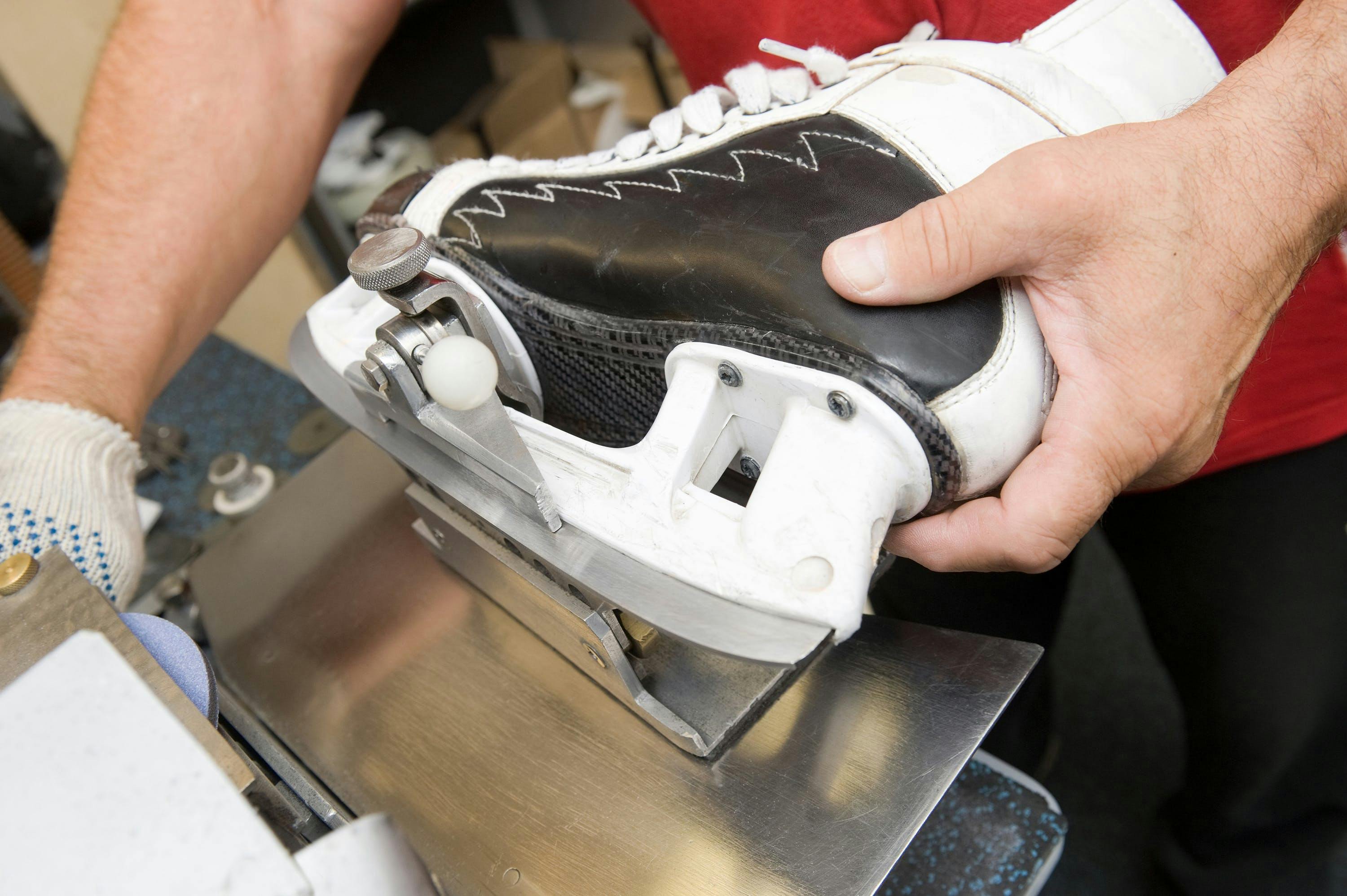You’ve been battling it out on the ice, and now it’s time to sharpen those blades. You take your skates to the pro shop and the tech asks you “What blade radius depth do you want?” Um, well, what skate blade depth should I get? What does “radius depth” even mean? What’s the difference between shallow hollow versus deep hollow? Does it matter if I’m a goalie or a forward? Does my weight make any difference? If these are the kinds of questions running through your head, then read on! You definitely don’t want to get this wrong.
What the Radius of a Blade Means Geometrically
The radius of a skate blade corresponds to the hollow shape that is ground into the bottom when it’s sharpened. As you have no doubt noticed, that hollow has a circular shape, which means it has a radius. If you drew the complete circle formed by the hollow in your skate blade, the radius of that circle would be one half of its width (Radius = Diameter X ½). This hollow is made by pressing the skate blade against a grinding wheel via a diamond dressing attachment. The grinding wheel shapes (or dresses) the edge of the blade to the corresponding radius.
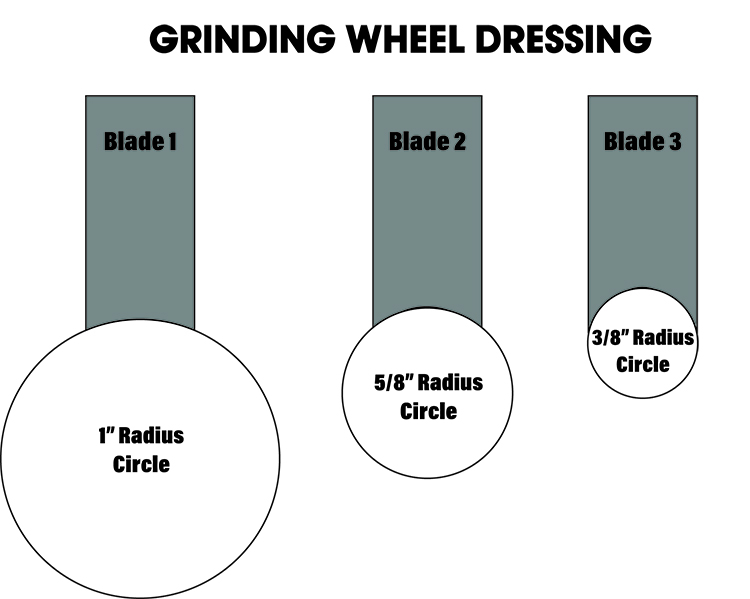
What the Radius of a Blade Means Practically
The radius of a skate blade will typically range between 1/4″ to 1¼”. You won’t see anything below 1/4″ for two reasons: anything lower is too sharp for any skater regardless of skill or discipline, and it can damage the grinding wheel used by the sharpener.
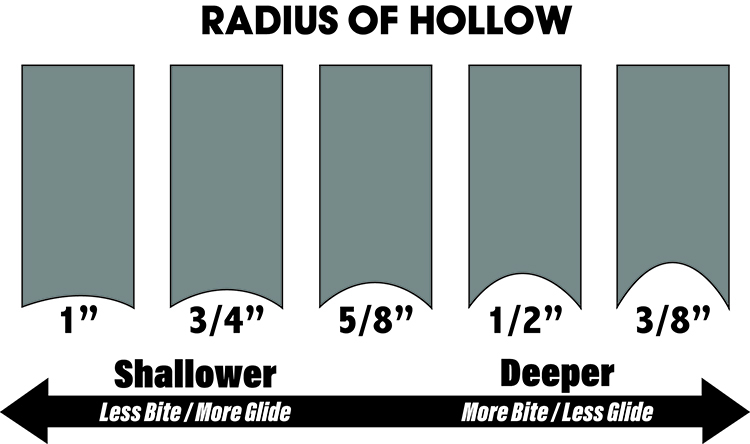
Shallow Hollow
A shallow hollow results from a large radius on your skate blade making them feel less pronounced. In addition, a shallow hollow means there will be less surface area of the blade in contact with the ice. Shallow hollow edges penetrate less into the ice than deep hollow edges will. As a result, the blades ride more on top of the ice and you’ll notice significant more glide. This reduced friction also means you can skate faster and use far less effort to keep your speed up, resulting in fresher legs as the game goes on.
The tradeoff of less surface area and ice penetration is less grip (or bite), meaning reduced maneuverability and quick stops.
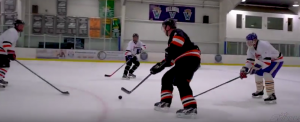
Shallow hollows are good for beginning skaters as they are learning new skills, and the blade radius can be reduced as they become more proficient at skating. Shallow hollows are also recommended for skaters that need to make routine stops and changes in direction (e.g., hockey players), or drifting moves like one-timers.
Deep Hollow
A small radius creates what is referred to as a deep hollow. A deep hollow means more grip on the ice (more bite, so to speak). Because the blades grip the ice more, you can accelerate more quickly and turn much more tightly than you can with a shallow hollow. This depth results in much more pronounced edges along your blades with a “sharper” feel. You can also expect more surface area in contact with the ice as the blade penetrates into the ice more.
As far as your skating, you can expect more drag and less glide because there is more friction to overcome, and thus you’ll have to work harder. The blades will also grip the ice better, which on one hand allows you to accelerate better and gives you more turn control, but on the other reduces your overall maneuverability and ability to stop. If you’ve ever gone “over the top” of your skates, or felt your skates chatter while stopping, your hollows are probably too deep.
Someone on the lighter side can probably tolerate a deeper hollow with a smaller radius without any major problems. If you are on the heavier side, your skates are liable to grip the ice so well that stopping becomes quite treacherous. Most of the time, smaller radii are recommended for professional figure skaters or ice dancers who need to be able to make tight turns and land with strong grip after performing a jump.
Blade Radius vs Blade Profile
It is important that you don’t get the blade radius and the blade profile (also known as the blade rocker or contour) mixed up. You view the blade radius by looking down the blade from the front or back of the skate. You view the blade profile by looking at the skate sideways. The blade profile affects how much of the length of the blade is in contact with the ice. A larger profile means more of the blade is in contact with the ice, which means more stability and less maneuverability. A smaller profile means the opposite: more agility, but you are likely to get fatigued more quickly.
A Note on Blade Edges

Regardless of whether you have your skates sharpened to a small or large radius (i.e., deep hollow or shallow hollow) the edges will still be sharp. The issue with sharpening your blades is not whether or not they will have an edge (even speed-skating blades still have an edge) but rather how much of an edge they have. When people complain that their skates are not sharp enough, what they usually mean is that the skates do not have enough of an edge to suit their particular skating style.
A savvy sharpening tech will even take into consideration the time of year when dictating hollow depth. During warmer months, ice rinks tend to have softer ice and thus blades naturally penetrate deeper. It’s not uncommon to step down one radius depth (that is, if you normally use 5/8” to go to 3/4”) to achieve similar performance as on firmer ice surfaces found during colder months.
Getting The Most Out of Your Skate Blade Sharpening
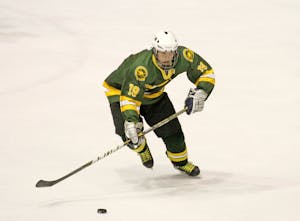
If you want more bite, get a shallow hollow with a larger radius; for less bite, go with a deep hollow and a smaller radius. For young people through high school that play hockey, a 1/2″ radius is most common. Goalies will often opt for a larger radius on the order of 1” to 1 ¼” while forwards prefer a smaller radius. If you are very lightweight, a 3/8” radius is probably what you need. Light to average weight skaters typically have a radius of 1/2″ to 5/8” while heavier skaters usually opt for about 3/4″ to avoid chattering when they try to stop.
Shinny USA
Once your skates are finely tuned and ready, come join Shinny. Shinny USA provides opportunities to participate in non-competitive, recreational hockey for players of varying levels of skill and experience. We offer hockey programs at several locations in Pennsylvania and Delaware and mini-tournaments throughout the year. If you love hockey and want to play in a low-pressure atmosphere, then contact Shinny USA today!
